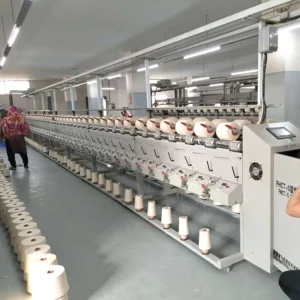Yarn doubling machines are a necessity in the textile industry. These machines increase the quality and efficiency of the yarns.
However, like any machinery, there can be certain problems due to which their performance is adversely affected.
Understanding such common problems and solutions helps you keep the operation running optimally and assure the quality of your final product.
In this article, we will talk about some of the frequent problems you encounter with yarn doubling machines and also provide some feasible solutions.
Yarn Breakage During Doubling Process
Common Causes of Yarn Breakage
1.Quality of Yarn
Poor-quality yarn usually has weak points or irregularities, making them more liable to breakage.
To minimize this risk, one needs to always get this yarn from suppliers who provide consistent, high-quality material.
2.Poor Machine Calibration
Calibration is a frequent procedure needed to keep your yarn doubling machine running smoothly.
If the machine is not well calibrated, then undue stress might be caused on the yarn, which could be a point accountable for yarn breakage.
The machine does require periodic checking and adjustment to remain at an optimum performance level.
Solution
1.Regular Checks
Regularly check the tension settings and readjust them according to the type of yarn you are working with.
Attention to such little details goes a long way in preventing incidents of breakage.
2.Quality Material
This reduces the chances of breakage, besides improving the quality of your final product.
3.Regular Machine Maintenance
Make sure you consider regular maintenance and calibration of the yarn doubling machine.
This will ensure that any potential problem is noted well before actual increased breakage occurs.
Uneven Yarn Thickness or Snarling
Common Causes of Uneven Yarn Thickness or Snarling
1.Inconsistent Yarn Feed
When there is inconsistency in feeding the yarn, then this naturally leads to variation in the thickness of yarn at different sections resulting in thicker and thinner areas.
For this, smooth and consistent operation of the feed mechanism is important.
2.Dirt and Debris
Accumulation of dust, lint, and other debris can impact performance and result in snarling and tension changes.
For this reason, periodic cleaning of the machine will not only ensure performance at an optimal level but also prevent such conditions.
Solution
1.Yarn feed monitor
The mechanism of yarn feed has to be continuously monitored for its proper functioning.
It may involve certain adjustments that need to be carried out on a routine basis so that uniform yarn feed into the machine is maintained.
2.Cleaning of the machine
A routine has to be followed in cleaning the machine so that dust and debris accumulation may be minimized.
Inaccessible areas may be cleaned with compressed air or soft brushes to see that the machine functions efficiently.
3.Regular Maintenance
Institute a good maintenance program that checks, on a routine basis, components that may need some adjustment or replacement. Be proactive and ensure quality in yarn consistency and minimize defects.
Machine Jamming or Malfunctioning
Causes of Machine Jamming
1.Foreign Objects
Undesired entrance of small foreign objects into the machine is one of the most frequent causes of jamming.
Parts of fabrics, tools, and sometimes a lot of lint that gathers in the workplace are examples. When these objects get lodged in critical areas of the machine, they may disrupt the normal operation of the yarn doubling process.
2.Worn-out parts
Some of the parts that may be targeted by this include gears, belts, and rollers.
This might result in massive malfunction, which may involve expensive repairs or replacement if not timely acted upon.
Solution
A possible mitigation against this would involve developing a rigorous cleaning schedule.
Regularly inspect the workspace to ensure debris and foreign objects are not in the workspace.
This will involve regular inspections on machines in order to find and replace parts that show wear potential, which causes larger problems down the line.
The more proactive a maintenance program is, the lower the occurrence of machine jamming will be and help production proceed without disruptions.
Dust or Debris Accumulation in the Machine
Effects of Dust and Debris
1.Reduced Efficiency
Surplus dust and dirt, over time, can cause overheating that might burn out the efficiency of the machine.
When dust gathers with time in the vital machine areas, it blocks airflow, making the machinery work much harder than it actually needs to, which is a waste of energy and may even cause breakdowns.
2.Quality Issues
The presence of debris can lead to the contamination of the yarn, thereby making them defective.
Besides causing dissatisfaction among your customers, such inconsistency in yarn quality will also hamper your reputation as a supplier.
Cleaning of the Environment is an essential pre-requisite for quality yarn production.
Solution
You will want to establish a routine cleaning schedule for yarn doubling machines in order to combat dust and other types of buildup.
Clean those blind areas regularly with compressed air or soft brushes, making sure all parts are free from any build-up.
By keeping the machine clean, you will not only be assured of running efficiency but you will also be protecting the quality of your yarn products.
Electrical or Mechanical Issues and Their Solutions
Common Problems
1.Loose Connections
Over time, connections tend to loosen due to continuous vibration and normal use; sometimes, this causes intermittent failures or absolute operational shutdowns.
Regular checks are thus essential to ensure all electrical connections are tight and working correctly.
2.Smearing
Inadequate lubrication of parts causes seizing, eventually leading to mechanical failure, which can result in lost production.
Adherence to the manufacturer’s recommendation on the lubrication schedule is paramount to optimum performance.
Solution
Adhere to regular electrical tests to ensure that each connection is tight and secure. Perform a program of regular lubrication of moving parts, using the correct lubricants according to the manufacturer’s recommendation.
Electrics and mechanical malfunctioning can be avoided by proactive processes of yarn doubling machines, thus keeping it up to date and reliable for continuous production without unplanned stoppage.
Conclusion
Knowing some of the common yarn doubling machine problems will help keep your productivity high and at quality best.
You should be proactive to tension checking, maintaining cleanliness, and routine inspection to prevent most of these problems.
Proper maintenance practices will not only ensure more machinery life but also meet the exacting standards of your customers for the products they require from you.








